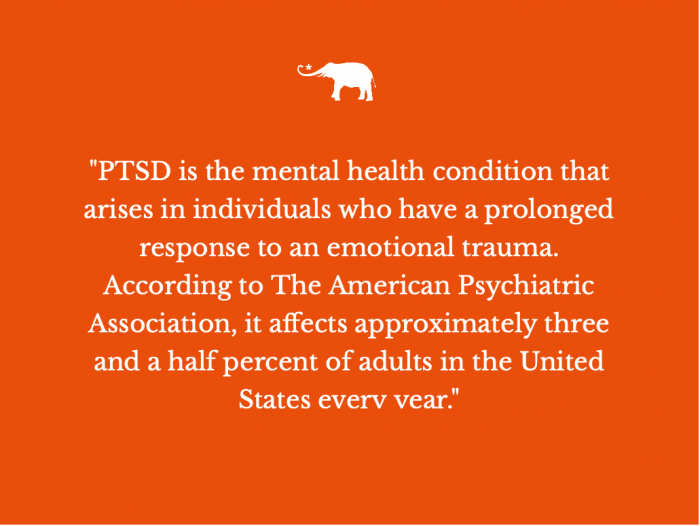*Editor’s Note: Elephant is not your doctor or hospital. Our lawyers would say, “This website is not designed to, and should not be construed to provide medical advice, professional diagnosis, opinion, or treatment to you or any other individual, and is not intended as a substitute for medical or professional care and treatment. Always consult a health professional before trying out new home therapies or changing your diet.” But we can’t afford lawyers, and you knew all that.
The deep emotional wounds left as a result of having experienced or witnessed an intense traumatic event can have devastating and long-lasting effects on someone’s life.
It is estimated that one in three people who have experienced an extreme traumatic event will develop post-traumatic stress disorder (PTSD).
PTSD is the condition that develops when the effects of the trauma do not resolve within a month and which lead to significant problems in daily functioning.
Trauma is the psychological state that results after experiencing something that is unexpected and intensely disturbing. In most cases, the person feels a sense of danger or the threat of bodily harm, as well as a sense that they were not in control.
Unresolved emotional trauma can have a devastating impact on every facet of life, from relationships to career, as well as overall health and quality of life.
Emotional trauma defined:
When we encounter an unexpected, shocking event, our bodies immediately initiate the “fight-or-flight” response. This is a chemical response during which the brain sends the signal, “fear,” through the central nervous system, which leads to a flood of adrenaline and cortisol. These are the stress hormones that help us to react quickly to a threatening situation.
Examples of traumatic events might include:
>> Abandonment.
>> Childhood sexual abuse, neglect, or physical assault.
>> Sexual abuse or rape.
>> Sudden death of loved one.
>> Violent assault.
>> Serious injury or illness.
>> Witness to a violent event.
>> Natural disasters.
>> Combat trauma.
>> Serious car accident.
>> Witness to suicide or murder.
While traumas are extremely upsetting and even life-altering, most people will not suffer from them for a prolonged period of time. Depending on an individual’s coping mechanisms and resilience, after a certain amount of emotional processing and healing has occurred, the symptoms of distress will begin to fade.
For others, the effects of the trauma remain a daily struggle and can cause serious impairment in functioning. Substance abuse is common in people who have difficulty after a trauma, as they use the substance to help self-medicate the psychological distress.
Trauma disorders can also cause disruption in work, relationships, and family relationships. In addition, those with trauma disorders may also struggle with features of anxiety disorder, obsessive-compulsive disorder, or dissociative disorder.
PTSD defined:
PTSD is the mental health condition that arises in individuals who have a prolonged response to an emotional trauma. According to The American Psychiatric Association, it affects approximately three and a half percent of adults in the United States every year, and an estimated one in 11 people will be diagnosed with it in their lifetime.
PTSD symptoms are presented in clusters. There are four clusters, so for PTSD to be diagnosed, there must be a specific number of symptoms from each cluster that have persisted for more than a month.
The four clusters include:
1. Reliving the trauma.
Unwanted thoughts or memories of the trauma are experienced repeatedly through flashbacks, vivid memories, or nightmares. The person may experience chills, heart palpitations, or feelings of panic upon reliving the traumatic event.
2. Avoidance.
In order to avoid triggering the distressing emotions associated with a past trauma, someone with PTSD will avoid any people, situations, or places that might trigger the disturbing memories. They will avoid discussing the trauma as well, and withdraw from family and friends. A sense of detachment is also common.
3. Hyper-arousal.
Someone with PTSD might be on edge, jumpy, easily irritated, is quick to anger, easily frightened, and have an exaggerated startle response. The individual may suffer from panic attacks or insomnia. Drugs or alcohol may be used to self-medicate these anxiety symptoms.
4. Negative thoughts.
People suffering from PTSD may display a sense of hopelessness and negativity in their attitude. They may talk down about themselves and exhibit negative emotions, such as anger, guilt, shame, and fear, and even blame themselves. They may be unable to recall details about the trauma. They may struggle with relationships.
Treatment:
When an individual is struggling to overcome the effects of the trauma, it is appropriate to seek treatment from a mental health professional. Treatment is provided in different levels of care, including outpatient or residential mental health programs.
Overcoming trauma will involve reclaiming your personal power, shifting focus from the past to the present, and reducing the impact of the trauma on your daily life.
Mental health professionals use a variety of therapies to assist patients in overcoming the disruptive effects of the trauma. These include:
>> Trauma-focused cognitive behavioral therapy (TFCBT). This is designed to help patients overcome trauma by reshaping the thoughts associated with the trauma. By helping the trauma victim express their feelings about the experience, the therapist will show them how those thoughts have led to withdrawal, guilt, loneliness, anxiety, and other negative emotional states. Through examining the negative thoughts and reframing them in a more productive manner, the trauma eventually loses potency.
>> Psychodynamic therapy. This is a longer-term therapy that examines childhood experiences, including any childhood history of trauma. The insights gained through psychodynamic therapy can help the individual resolve past emotional trauma, as well as to improve dysfunctional adult relationships.
>> Exposure therapy. This is a short-term behavioral therapy that helps individuals become less sensitive to the memories or triggers of the trauma. By encouraging discussion of the event and gradually exposing them to the triggers within a safe environment, the impact is gradually reduced over time. This helps with the avoidance behaviors they may have acquired following the trauma.
In addition to the various evidence-based psychotherapies, there are some excellent adjunctive therapies that complement traditional therapies. These include:
>> Eye movement desensitization and reprocessing (EMDR), which is a type of therapy that helps individuals by desensitizing them to the disturbing memories of the trauma. EMDR is an eight-phase program that involves the client following, with their eyes, an object, or finger back and forth while discussing the disturbing event.
>> Neurofeedback, which is a type of biofeedback where the individual’s brain wave patterns and activity can be modified through a computer software program. This trains the individual to be calmer when thoughts of the trauma arise.
>> Holistic activities, which can help keep stress under control, especially when thoughts of the event are upsetting. Managing stress through deep breathing exercises, mindfulness, guided imagery, yoga, massage therapy, and acupuncture can be beneficial in trauma recovery.
Although experiencing a significant emotional trauma is highly destabilizing, there are effective treatments that can help you safely work through the event.











Read 1 comment and reply